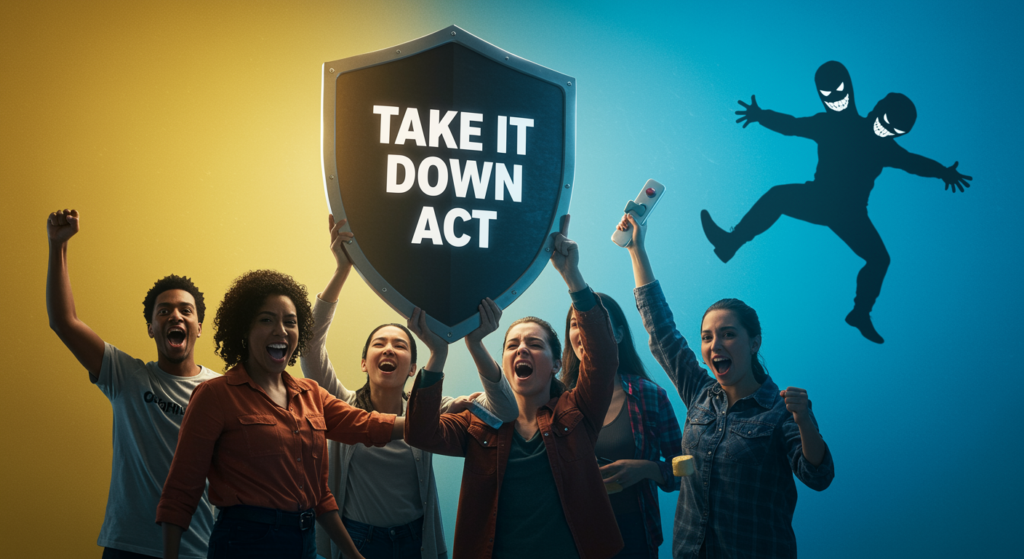
Take It Down Act Passes: Combating Nonconsensual Deepfakes and Revenge Porn
Landmark Legislation Addresses Online Exploitation with the Take It Down Act
In a major win for digital rights and victim protection, the Take It Down Act sailed through the U.S. House of Representatives on April 29, 2025, with a resounding 409-2 vote. This bipartisan effort, which the Senate had already approved unanimously, now heads to President Donald Trump for final signature.
The Take It Down Act directly confronts the surge in nonconsensual intimate imagery, including AI-driven deepfakes and traditional revenge porn that devastate lives. By forcing platforms to act fast and holding creators accountable, it’s a game-changer for online safety. Have you ever wondered how quickly harmful content could vanish from the web? This law aims to make that a reality.
Understanding the Take It Down Act’s Key Provisions
The Take It Down Act, officially the “Tools to Address Known Exploitation by Immobilizing Technological Deepfakes on Websites and Networks Act,” sets up a federal shield against unauthorized explicit content. It criminalizes sharing intimate visuals, whether real or AI-generated, without consent, and mandates platforms remove such material within 48 hours of a report.
This legislation zeroes in on the evolving threat of deepfake technology, which uses AI to fabricate realistic images that can ruin reputations in an instant. Key elements include fines, jail time, and restitution for offenders, plus a straightforward process for victims to flag and eliminate harmful posts.
- It explicitly outlaws nonconsensual publication of intimate depictions, covering both revenge porn and deepfakes.
- Platforms must respond to reports swiftly, ensuring victims aren’t left in limbo.
- The act clarifies that creating content with consent doesn’t mean it’s okay to share it publicly, a vital distinction in today’s digital world.
Why does the Take It Down Act matter so much? It fills gaps in state laws, especially for deepfakes, offering uniform protection across the U.S. Imagine a teen facing fabricated explicit images—under this law, help is just a report away.
Bipartisan Push for the Take It Down Act
Amid political divides, the Take It Down Act stands as a beacon of unity, led by figures like Senator Ted Cruz and Senator Amy Klobuchar. In the House, Representatives Maria Elvira Salazar and Madeleine Dean drove the charge, showing how shared concerns can bridge party lines.
First Lady Melania Trump added her voice, joining a roundtable with survivors and advocates to highlight the risks to young people from deepfakes and revenge porn. Her involvement underscores the human side of this issue—think about how malicious online content can affect families and communities.
Cruz drew from real stories, like that of Elliston Berry, a teen whose life was upended by a classmate’s deepfake creation. “It shouldn’t require a senator’s intervention to remove such content,” Cruz emphasized, pushing for accessible solutions. If you’ve dealt with online harassment, this act could be the tool you’ve been waiting for.
Responding to the Rise of Deepfakes and the Take It Down Act
The Take It Down Act emerges as a direct counter to the explosion of nonconsensual intimate imagery, a problem that’s outpaced many state laws. Only 20 states currently address deepfake abuses, leaving millions vulnerable to this tech-fueled harm.
Researchers note a sharp increase in explicit deepfakes as AI tools become more accessible, turning everyday users into potential perpetrators. Cruz celebrated the passage online, crediting survivors and advocates for their role in making the Take It Down Act a reality—it’s a testament to collective action against digital threats.
What if your private images were misused? This law not only criminalizes such acts but also ensures platforms prioritize victim reports, potentially preventing long-term damage.
Deepfake Challenges and the Take It Down Act’s Role
Diving deeper, the Take It Down Act targets how AI manipulates reality, creating convincing yet false content that mimics real people. This isn’t just about technology; it’s about protecting personal autonomy in an era of rapid innovation.
Victims often face hurdles in getting content removed, but this act streamlines the process, reducing emotional strain. By enforcing quick takedowns, it could deter future abuses and foster a safer online space.
The Human Toll of Nonconsensual Imagery and the Take It Down Act
Behind the headlines, stories like Elliston Berry’s reveal the deep psychological scars from revenge porn and deepfakes. Mental health experts, such as Katie Hurley from The Jed Foundation, warn of anxiety, depression, and even suicidal risks for victims.
The Take It Down Act recognizes this as a form of sexual abuse, aiming to mitigate ongoing trauma through rapid content removal. Berry’s advocacy shows how one person’s experience can spark nationwide change—could sharing your story make a difference, too?
For parents and educators, this law offers actionable steps: monitor online activity and know how to report issues quickly under the new rules.
Enforcing the Take It Down Act Effectively
Once signed, the Take It Down Act will compel online platforms to have robust reporting mechanisms in place, with the Federal Trade Commission overseeing compliance. Penalties for non-compliance include hefty fines and prison terms, especially in cases involving minors.
This means tech giants like Snapchat and Meta must step up, potentially integrating AI tools to detect and remove harmful content faster. If you’re a victim, the act provides clear guidance on filing reports, turning a daunting process into something more manageable.
Experts suggest platforms could use this as an opportunity to build trust—imagine apps that notify users of potential deepfake risks before they spread.
Addressing Opposition to the Take It Down Act
While the Take It Down Act enjoyed broad support, a couple of representatives, like Thomas Massie, raised concerns about overreach and unintended effects. He worried it might stifle free speech or lead to abuses, but these views were in the minority.
Most lawmakers see the Take It Down Act as a balanced approach, focusing on egregious cases without broad censorship. This debate highlights the challenge of regulating tech without hampering innovation—what do you think balances privacy and expression?
In the end, the overwhelming vote affirms that protecting individuals from exploitation outweighs these risks.
Industry Adaptation and the Take It Down Act’s Future
Tech companies have already signaled support for the Take It Down Act, with Cruz’s team collaborating on its development. This buy-in from firms like Meta ensures smoother implementation, as they’ll need to enhance their content moderation tools.
The 48-hour rule is a big shift, pushing platforms to prioritize user safety over delays. For everyday users, this could mean less time suffering from online abuse and more control over their digital footprint.
If you’re in tech, consider how your company can adopt similar policies—small changes, like better reporting buttons, could make a real impact.
Next Steps for the Take It Down Act
With congressional approval secured, the Take It Down Act awaits President Trump’s sign-off, which seems likely based on his prior statements. Once enacted, it’ll pave the way for more AI regulations, setting a precedent for handling emerging threats.
This isn’t just about one law; it’s part of a larger movement toward ethical tech use. Victims will soon have stronger tools to reclaim their privacy, potentially inspiring global standards.
Have you encountered online harms? Sharing experiences in the comments could help others navigate these issues.
A Final Look at the Take It Down Act’s Significance
The Take It Down Act marks a pivotal moment in fighting digital exploitation, offering hope to those affected by nonconsensual content. By enforcing accountability and swift action, it addresses long-standing gaps in protection.
As we move forward, staying informed and advocating for updates will be key. What are your thoughts on how this could evolve? We’d love to hear from you in the comments or via our related posts on online safety.
Ready to learn more? Explore our guides on digital privacy and share this article to spread awareness. Together, we can build a more secure online world.
References
- CBS News. “House passes ‘Take It Down Act’ to help victims of deepfake pornography.” Link
- ABC6 on Your Side. “Take It Down Act passage intended to empower victims of deepfakes, revenge porn.” Link
- Fox 4 News. “Deepfake porn bill passes House with Ted Cruz’s support.” Link
- Cruz Senate Office. “Bipartisan Take It Down Act heads to President’s desk.” Link
- Fox News. “Revenge porn bill backed by Melania Trump passes House.” Link
- Daily Wire. “House passes Melania-backed bill to fight deepfake revenge porn.” Link
- Substack Post. “Details on deepfake legislation.” Link
- MyNBC15. “Take It Down Act aims to empower victims.” Link
Take It Down Act, deepfake pornography, revenge porn, nonconsensual intimate imagery, Ted Cruz, Melania Trump, online exploitation, AI-generated content, digital safety, victim protection







